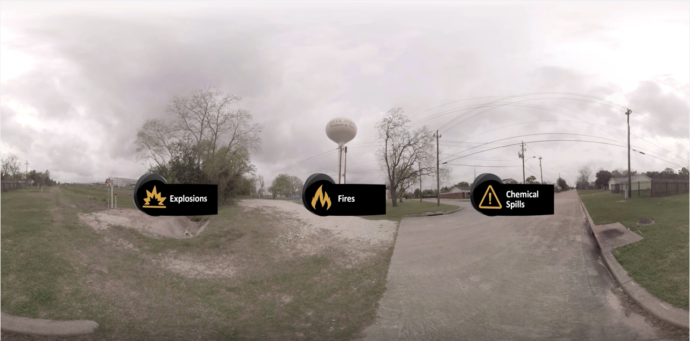When one sails down the Houston ship channel, one glides past sleeping giants. Melody Jing had waited two months to get out of the classroom and get the chance to point a 360 camera at these grey mammoths. For everyone else on the ship, it may have been difficult to imagined that a year and a half later, the water’s edge would spill out to consume Houston’s streets during hurricane Harvey. But Melody and the rest of her JOVRNALISM class had a inkling this was going to happen, and were already taking action.
Jing and the rest of her JOVRNALISM class had learned in the Spring of 2016 that the ship channel is the second largest in the country and is the most vulnerable. The Texas Tribune and Propublica discovered in an investigative report that there was a possibility of immense damage from a storm surge, a weather phenomena that essentially creates a tsunami during a hurricane, in the channel. Knowing immersive video would carry the message further, the two publications reached out to journalism professor and AnnLab faculty associate, Robert Hernandez, and together they decided to take on the project as part of the JOVRNALISM class. They brought the class to the river’s edge to create a virtual reality experience.
The hackathon style class has been experiencing with 360 video, augmented reality and even google glass for the past three years, but none harnessed the power of virtual reality technology for the same public service purposes quite like their project in Houston. The collaboration was all in an effort to bring the findings of their investigative report to life and publicise early warning signs of storm threats to Houston thought a documentary called Hell on High Water. In doing so, the class was able to participate in proactive disaster reporting.
“The tanks are all stacked very close together. A lot of them on both sides of the ship channel. It definitely looked vulnerable to us,” said Melody Jing, one of the students who flew to Houston to participate in the experimental journalism class. “If that river was to flood, those tanks are right next to the water. We could see how dangerous it could be.”
Then Harvey happened.
Luckily, Houston did not experience a storm surge during Harvey. However, the rest of the Texas Tribune’s report did come true, like the explosion of a petrochemical plant near the water’s edge. After Harvey, the class understood how important journalism can be to public safety, and how virtual reality could allow more people to take warnings seriously when the threat seems distant.
“We tried to shared different chapters of our project as the hurricane hit to give people a sense of what could happen. I think this project truly proves that this new immersive technology has a strong role to play in journalism” said instructor Robert Hernandez.
360 video placed viewers on the bow of the ship going along the ship channel and allowed for a more intimate look at the surrounding neighborhoods and petrochemical plants on the shores. The class learned that virtual reality was very much a visceral experience and when paired with other immersive technology could become a very powerful communication tool. The team focused heavily on virtual reality technology that simulated a 30-foot wall of water that would manifest during a storm surge. Viewers are able to see how houses on stilts can still be consumed by a wave.
“When you see it in a picture, you don’t get the scale of how big these tanks are…You couldn’t imagine these tanks getting washed away by a surge. It gives you a little chill inside when you think about it. When I saw the image of hurricane Harvey on television I was piecing in my mind the hurricane Ike image of the tanks that we saw” said Jing.
All of this technology allowed for the human elements of the stories to come out even stronger and invited more proactive storytelling. One person who stuck with Jing was Donald Matter, the former mayor of Nassau Bay, a city adjacent to Houston. He was attempting to raise the foundation of his house when the class came to Houston, given it’s location in the hundred year flood zone made it susceptible to extreme flooding.
“Now that I think about it I’m really concerned about the [former] mayor of Nassau Bay. He was mayor for that area during hurricane Ike, hurricane Rita, and… he was still living there.” said Jing. “I wonder if [raising his house] actually worked for him.”
The JOVRNALISM class gained a once in a lifetime opportunity to be on the frontlines of one of the country’s most devastating hurricanes. Post-Harvey, Professor Hernandez has been discussing with his students some of the hard lessons that were realized while in Houston that students will take with them into their careers.
“Our goal was to use new technologies for immersive storytelling to get people to care and act before the predicted disaster would strike. I am proud of the journalism experience that we produced, but there was no joy in seeing the destruction happen.”
